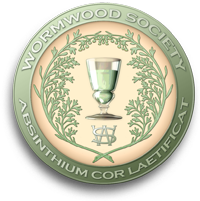Systematic Misinformation about Thujone in Pre-ban Absinthe - Reviewed by Experts and Consumers at The Wormwood Society
Systematic Misinformation about Thujone in Pre-ban Absinthe
Summary
The media coverage about absinthe, a bitter spirit containing wormwood (Artemisia absinthum L.), continues to repeat unsubstantiated myths and legends and the public is systematically misinformed. Especially, the theory about a significant thujone content in absinthe must be put into perspective ...
Summary
The media coverage about absinthe, a bitter spirit containing wormwood (Artemisia absinthum L.), continues to repeat unsubstantiated myths and legends and the public is systematically misinformed. Especially, the theory about a significant thujone content in absinthe must be put into perspective as there are a number of different wormwood chemotypes with a large variance in thujone content (0–70.6 % in essential oil) from which a mean thujone content of about 20 mg/l in distilled absinthe with a large standard deviation of up to 20 mg/l may be calculated. However, a higher thujone amount of 260 mg/l derived from erroneous and out-ofdate calculations is generally presented as “historical content” in addition to reports about unsubstantiated psychoactive or aphrodisiac properties. Other studies used unauthentic recipes with unrealistically high amounts of wormwood that would produce undrinkable bitter products. In general, a previous overestimation of the thujone content of pre-ban absinthe was detected.
Some relevant excerpts:
Absinthe – a bitter spirit containing wormwood (Artemisia absinthium L.) and other herbs – was one of the most popular alcoholic beverages in late 19th century Europe. Renewed interest in absinthe has been raised by the fact that after a century-long prohibition in many European countries, wormwood was re-legalised as an ingredient of alcoholic beverages in 1988, and currently over 100 types of absinthe are legally available.
It is remarkable that the media coverage about absinthe continues to repeat unsubstantiated myths and legends, and in the scientific as well as in the lay literature the public is systematically misinformed.
* * *
A wide variation in the oil content of wormwood and even wider variations of the thujone content in the oil is notable. A number of different chemotypes was found in the studies with α-thujone, cis-chrysanthenyl acetate, cis-chrysanthenol, cis-epoxyocimene, sabinyl acetate or bornyl acetate as principal component. Some chemotypes did not contain thujone at all, for example chemotypes from France, Italy, Spain, Lithuania, and Egypt. It is therefore possible to produce absinthe without any thujone.
* * *
So much attention is focused on absinthe’s myths and supposed effects that almost everyone has forgotten that it was once a gourmet product with all the finesse of the best high quality spirits. The figure of 260 mg/l of thujone that was repeated over and over might have kept producers at the beginning of the absinthe renaissance in the 1990s from using historical recipes such as those of Duplais. Only in recent years, have a number of authentic distilled absinthes become available on the market. Our analyses showed that such products easily do comply with the thujone maximum limits and this fact may also prove the prior overestimation of the thujone contents.
Download the full article:
![]() Systematic Misinformation about Thujone in Pre-ban Absinthe, 140k PDF
Systematic Misinformation about Thujone in Pre-ban Absinthe, 140k PDF
